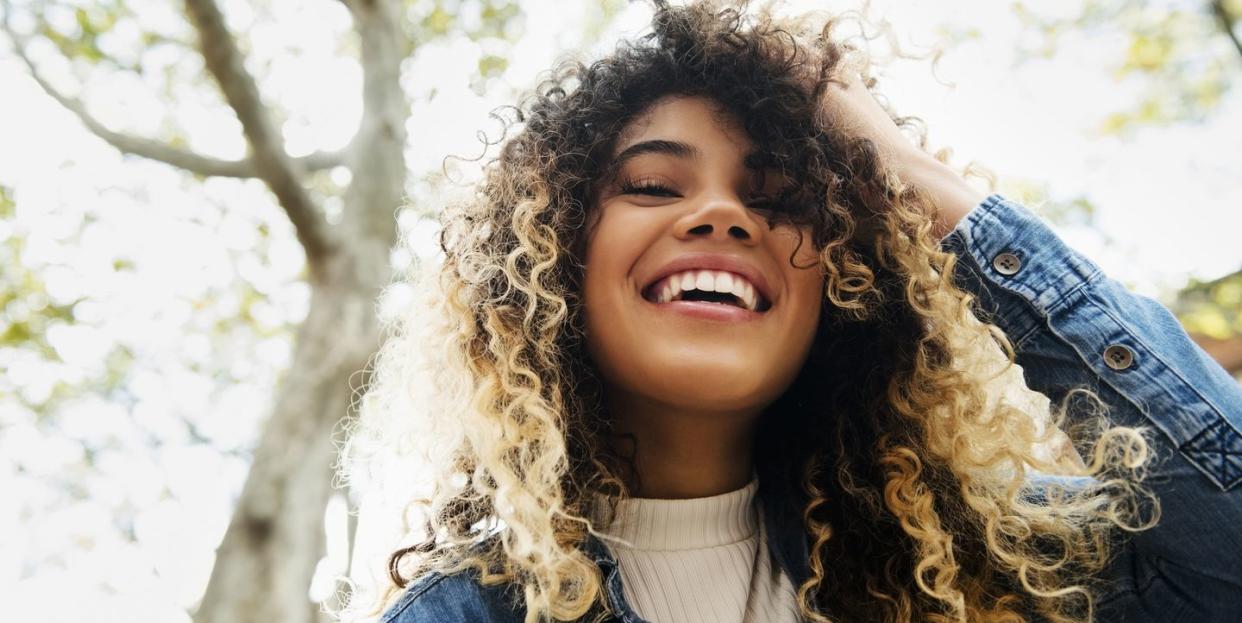Everything You Need To Know About Type 3A Hair, Per Experts

If you have curly hair and you've heard of the hair typing system, there's a chance that at least some point you've been slightly confused about what your own curl pattern is.
Meet Our Experts: Janelle Sands, a Texas-based curl specialist, Candace Witherspoon, a New York-based curl specialist, hairstylist, and owner of Candace Witherspoon Salon.
Explained simply, there are four hair types: straight, wavy, curly, and coily. Type 2 hair is usually wavier than straight, type 1 hair. Type 4 hair is of a kinkier texture, and right in the middle of the curly spectrum lies type 3 hair, which usually consists of loose to tight curls. 3A hair specifically is a fairly common curl type, though it's not always easy to identify because of its similarity to other curl patterns in the type 3 category.
If you're curious to know if you fall under the 3A category, we spoke with two curly hair specialists to find out exactly what separates these curls from all the other types out there. Plus, details on how to maintain them for overall healthy, defined hair.
What does 3A hair look like?
If you've looked at an online curl type chart, you may have noticed that 3A curls are a bit looser than 3B or 3C hair. "Falling in between wavy and coily hair, type 3 curly hair can be characterized by the definitive 's' pattern of the curl, rather than a 'z' pattern typically seen within the type 4 range," says Texas-based curl specialist Janelle Sands.
3A hair may also appear dry despite products being able to absorb into the hair easily. "The scalp sebaceous glands have quite the route of curves to travel from root to tip, so dryness is a continual concern for type 3A hair," she adds.
Sebaceous glands are found in your hair, and they secrete sebum, the oil that prevents your hair from getting dry, per the Cleveland Clinic.
How does 3A hair differ from other curl types?
As previously mentioned, type 4 hair tends to have a z-like shape rather than an "s." Additionally, type 2 curls are looser than 3A and can best be described as waves.
If you know you most likely have type 3 hair but aren't sure which letter you best align with, you can spot the difference through certain features. "Knowing that in the hierarchy of curls, this hair type follows the strongest wavy hair type, the 3A curl has the least amount of volume of the type 3 curly hair types," says Sands.
What's the best way to care for 3A hair?
Not all hair has the same needs. Here are a few do's and don'ts to help you get on the right track from New York-based curl specialist and stylist Candace Witherspoon:
Do
Diffuse and air-dry hair when styling
Use water-based products
Protect hair before bed using a silk scarf or pillowcase
Use protein treatments once a month
Don't
Wear tight or wet ponytails too often
Use chemical smoothing products
Use too many oil-based products
Blowdry your curls—this can damage and/or dry them out
Witherspoon recommends washing curls once a week and refreshing them every three days. "A lightweight conditioner and sulfate-free shampoo are highly recommended for 3A and all other curl textures—you want most of your products to be water-based," she says.
Then, to add moisture, apply a cream, mousse, or light-hold gel that will keep your curls hydrated throughout the week. If you need extra volume, diffuse your curls for about 20 minutes before letting them air dry.
If you like using oils, try using them sparingly to avoid weighing down your hair. "Curly hair tends to shy away from oils with the general fear that it could weigh the hair down, but oil is also a protectant," explains Sands. "Choose a light oil blend to apply to the tips of your hair to coat and ward against damage and breakage."
How can I maintain my curls after styling?
After spending tons of time washing and styling your hair, the last thing you want is to lose your look the next day. But hey, it happens!
Luckily, there are a few ways to keep your hair protected before it's time for a refresh. "After applying product to set your curls, do not touch the hair," says Sands. "Let the hair fully dry before picking up the roots or fluffing your style."
And when the day comes to an end, try putting your hair up and sleeping on a satin pillowcase. "I recommend wearing a bonnet with curls tucked in or a pineapple with a satin scarf," says Witherspoon "There is no wrong way, just what is best for your curls."
You Might Also Like
